Ultrasound-Guided Cardio-Cerebral Resuscitation in Patients with Severe Traumatic Brain Injury: a practical protocol
Abstract
Statement of the problem: Point of Care Ultrasound (POCUS) concept is the use of ultrasound techniques by non-diagnostic imaging physicians in order to answer a clinical question or perform a procedure at the patient's bedside. Development of high-resolution portable ultrasound devices allowed to application of POCUS in several medical specialties among which critical care medicine, emergency medicine, and anesthesia stand out. A good example is the introduction of the Focused Assessment with Sonography in Trauma (FAST and FASTe) protocols as a standard of care in the Advanced Trauma Life Support® curriculum. On the other hand, it is well known that severe traumatic brain injury (TBI) outcomes could be improved avoiding initial hypoxia and hypotension as is stated in the Emergency Neurological Life Support algorithm and our own experience. Transcranial doppler ultrasound (TCD), the so-called “stethoscope of the brain”, allows to know cerebral blood flow velocities and, toward them, identify states of low flow and high resistance. Orientation: Putting these concepts together and adding brain pathophysiology, we developed an Ultrasound-Guided Cardio-Cerebral Resuscitation (ReCCUs for the Spanish acronym of “Resucitación Cerebro Cardiovascular guiada por Ultrasonido”) in patients with severe TBI. In the image is the complete protocol. Conclusion: The ReCCUs protocol is proposed as an alternative to severe TBI management during initial resuscitation and golden hour. We think it would be more useful in developing countries where TBI treatment is usually not performed at the ER and patients spends hours until they are transferred to a trauma center or similar facility. The aim of the protocol is to bring a tool with targeted treatment in agreement with ATLS® methodological approach adding ultrasound in the “D” as have been done in the “C” with FAST and FASTe protocols, offering severe TBI patients an opportunity to improve both mortality and morbidity.
Open Access Journals
- Aquaculture & Veterinary Science
- Chemistry & Chemical Sciences
- Clinical Sciences
- Engineering
- General Science
- Genetics & Molecular Biology
- Health Care & Nursing
- Immunology & Microbiology
- Materials Science
- Mathematics & Physics
- Medical Sciences
- Neurology & Psychiatry
- Oncology & Cancer Science
- Pharmaceutical Sciences
